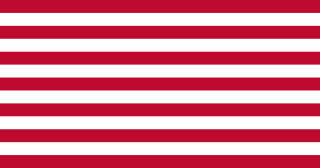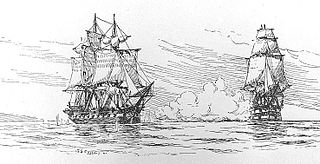The list of ship commissionings in 1785 includes a chronological list of all ships commissioned in 1785.
| Operator | Ship | Flag | Class and type | Pennant | Other notes | |
|---|---|---|---|---|---|---|
| Unknown | | HDMS Søehesten | Barge | [1] |
The list of ship commissionings in 1785 includes a chronological list of all ships commissioned in 1785.
| Operator | Ship | Flag | Class and type | Pennant | Other notes | |
|---|---|---|---|---|---|---|
| Unknown | | HDMS Søehesten | Barge | [1] |

The Continental Navy was the navy of the Thirteen Colonies during the American Revolutionary War. Founded on October 13, 1775, the fleet developed into a substantial force throughout the Revolutionary War, owing partially to the efforts of naval patrons within the Continental Congress. These congressional patrons included the likes of John Adams, who served as the chairman of the Naval Committee until 1776, when Commodore Esek Hopkins received instruction from the Continental Congress to assume command of the force.
HMS Victorious was a 74-gun third rate ship of the line of the Royal Navy, launched at Blackwall Yard, London on 27 April 1785. She was the first ship of the Royal Navy to bear the name.
Eleven ships of the Royal Navy have been named HMS Scorpion after the carnivorous arthropod, or the scorpion, a ballistic weapon in use in the Roman army:

HMS Leopard was a 50-gun Portland class fourth rate of the Royal Navy. She served during the French Revolutionary and Napoleonic Wars, and was notable for the actions of her captain in 1807, which were emblematic of the tensions that later erupted in the War of 1812 between Britain and America. She was wrecked in 1814.

Rear-Admiral Sir John Hindmarsh KH was a naval officer and the first Governor of South Australia, from 28 December 1836 to 16 July 1838.

Fougueux was a Téméraire-class 74-gun French ship of the line built at Lorient from 1784 to 1785 by engineer Segondat.
Several ships of the British Royal Navy have been named HMS Audacious.

Queen Charlotte was a British merchant ship launched in 1785 at Stockton for Etches & Co. Between September 1785 and 1788 she made a circumnavigation of the world in company with another ship that the company owned, the King George. The two vessels were engaged in the Maritime Fur Trade in the Pacific northwest. They sold their furs in China and returned to England with cargoes that they were carrying back for the British East India Company (EIC). In 1789 she was renamed Montreal. She was at Bordeaux at the outbreak of war with France in 1793 and the French government seized her.

The Océan-class ships of the line were a series of 118-gun three-decker ships of the line of the French Navy, designed by engineer Jacques-Noël Sané. Fifteen were completed from 1788 on, with the last one entering service in 1854; a sixteenth was never completed, and four more were never laid down.
Three ships of the Royal Navy have borne the name HMS Zealous, whilst another had been planned, but was cancelled.
HMS Burford was a 70-gun third rate ship of the line of the Royal Navy, built at Chatham Dockyard to the draught specified by the 1745 Establishment as amended in 1754, and launched in 1757.

Antonis Oikonomou was a Greek naval captain in the Greek War of Independence against the Ottoman Empire.

HMS Brilliant was a 28-gun Enterprise-class sixth-rate frigate of the Royal Navy. Brilliant was first commissioned in July 1779 under the command of Captain John Ford.

The Leon Trionfante class were a class of at least fourteen 70-gun third-rate ships of the line built by the Venetian Arsenale from 1716 to 1785, in four different series with minor changes in the ships' length. In 1797, when Venice fell to the French, Napoleon captured several ships of the class, still unfinished in the Arsenal: he chose one of them, forced the shipbuilders to have it completed and added it to his fleet en route for Egypt. After Campoformio, the remaining vessels were destroyed by the French to avoid their capture by the Austrian Empire.

Henrik Gerner (1742–1787) was a Danish naval officer who specialised in shipbuilding and naval architecture. His interests as an entrepreneurial engineer led to unsinkable gun platforms, horse-driven dredging machines, and desalination equipment for Orient-bound trading ships.